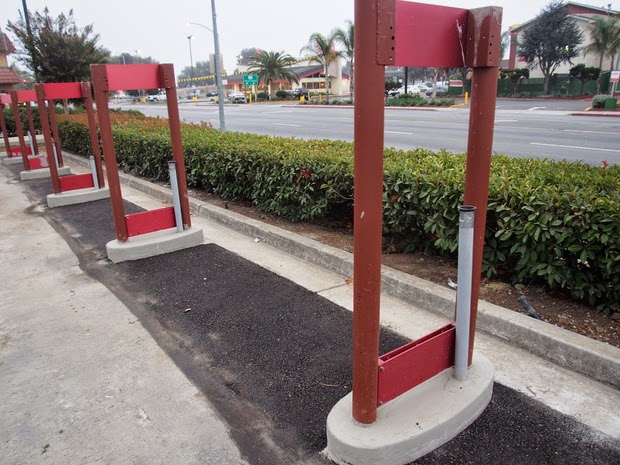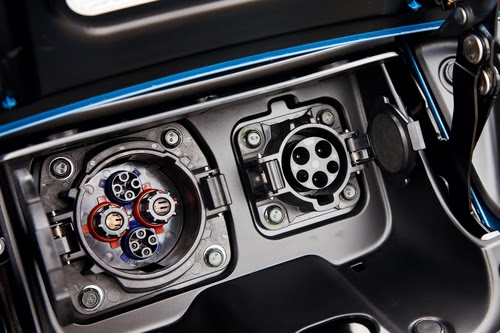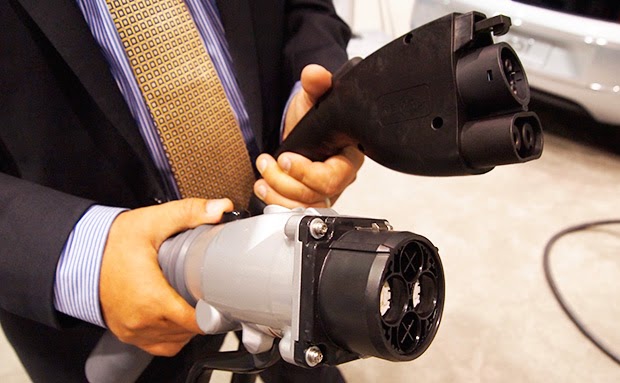In late March, CharIN e.V. made the briefest of announcements that looks to make a huge impact on the electric car charging scene: “CharIN e. V. is happy to announce that Tesla Motors Inc. has been granted core membership in the association on 24th of February 2016.” This is important because Tesla Motors has picked a side in the fast charging debate, and has sided with the Combo Charging System forces. CharIN is an automaker consortium leading the development of high power CCS charging, with a goal of 150 kW charging rate. This means the writing is on the wall, that the days of CHAdeMO’s viability are numbered. The result will take several years to play out, but it is inevitable. It’s also possible for Tesla Motors to take a huge market position as a high-power CCS provider simply by switching the plugs on the Supercharger stations.
Let’s do a little bit of a history review (there’s a full writeup of EV fast charging protocols elsewhere on LongTailPipe). In 2008 the first DC Fast Charging stations were installed in Japan. These supported the CHAdeMO![]() protocol developed between TEPCO and the Japanese automakers. A look at the PlugShare map for Japan shows the island is blanketed with over 6000 CHAdeMO stations. With over 3000 in Europe, 1600+ in the USA, the CHAdeMO fast charging infrastructure is well entrenched. The highest selling electric car, the Nissan Leaf, is compatible with CHAdeMO, as are a few other models. I myself own a Kia Soul EV, which supports CHAdeMO.
protocol developed between TEPCO and the Japanese automakers. A look at the PlugShare map for Japan shows the island is blanketed with over 6000 CHAdeMO stations. With over 3000 in Europe, 1600+ in the USA, the CHAdeMO fast charging infrastructure is well entrenched. The highest selling electric car, the Nissan Leaf, is compatible with CHAdeMO, as are a few other models. I myself own a Kia Soul EV, which supports CHAdeMO.
However, the SAE did not adopt CHAdeMO as the standard for DC Fast Charging. Instead the SAE J1772 committee decided to develop a different DC Fast Charging standard, Combo Charging Sytem. It uses a different plug and different control protocol. Along the way, many of the automakers sought to destroy CHAdeMO’s chance in the market – for example GM’s Shad Balch made trash talk against CHAdeMO at a California Senate Hearing on EV’s a few years ago. In general, the non-Japanese automakers have pushed strongly for CCS, while Nissan (and a couple other automakers) pushed for CHAdeMO. It meant CHAdeMO has had an early mover advantage, but in the long-run it seems likely to lose out given the majority of automakers support CCS.
Tesla Motors went its own way, developing the Supercharger network with a proprietary charging plug.
Famously Tesla CEO Elon Musk has repeatedly said Tesla Motors is open to other automakers adopting the Supercharger design — but only if the automakers pay into the costs of running the network. It seems to me the other automakers would not want to support the Supercharger network because they wouldn’t want to boost Tesla’s prestige. And in any case, Tesla Motors “shouldn’t” be owning refueling infrastructure. Isn’t there potential conflicting interests by selling not only the car but the refueling infrastructure? None of the other automakers own refueling infrastructure, in part for this very reason.
The CharIN website describes this mission statement:
- To develop and establish the Combined Charging System (CCS) as the standard for charging battery-powered electric vehicles of all kinds
- To draw up requirements for the evolution of charging-related standards and develop a certification system for use by manufacturers implementing the CCS in their products
- To promote the CCS standard worldwide
A few months ago CharIN announced plans to develop 150+ kW CCS charging. At around this charging rate proper road trips become feasible. The proof for that is Tesla’s Supercharger network which currently supports 120 kW charging (or faster) and which people routinely use for road tripping.

Tesla Motors as a core-team CCS proponent
With Tesla Motors joining as a “core member” doesn’t this imply Tesla Motors will shift its attention to supporting CCS? That would mean instead of three competing DC fast charging standards, the world would have two: CHAdeMO and CCS, with CHAdeMO clearly on the road to retirement.
Does it mean Tesla Motors will redesign the Supercharger stations to have CCS plugs?
Think of the impact of such a change. Tesla Motors would instantly become the largest provider of open-standards DC Fast Charging. The company would have a huge advantage over other network operators thanks to having deployed along major highway corridors.
Of course, Tesla Motors would have to solve the issue of authenticating users while not having any kind of touch-screen kiosk. Perhaps the plan would be to put QR-Codes on the charging stalls, and provide smart phone apps to manage charging sessions. Or, they could retrofit touch screens and card readers by replacing the shells at the charging stalls. The picture shown here is partly-installed Supercharger stanchions at the Gilroy Outlet Mall Supercharger location. When fully installed plastic shells fit over this, and it seems to me there’s lots of room inside those shells to add additional stuff like touch screens.
Another option is for Tesla Motors to sell adapters allowing a CCS car to plug into a Supercharger station. The adapter would supply an ID code to the Supercharger network, perhaps automatically billing a prearranged account with the adapter owner.

What’s the choices for CHAdeMO supporters
Nissan is the primary remaining CHAdeMO supporter. The company has sold over 200,000 Leaf’s, and perhaps 150,000 of those have CHAdeMO. There are additional CHAdeMO cars from other carmakers, like the Mitsubishi i-MiEV and the Kia Soul EV. None have had sales success to match the Leaf. The Soul EV did surpass 10,000 global sales recently, FWIW.
I think its time for Nissan et al to recognize the inevitable, and start planning their exit from CHAdeMO.
It’s not entirely feasible to retrofit CCS cords to existing CHAdeMO-only stations. For one thing that would negate the UL listing (or other certifications) on the equipment, making that idea a non-starter. The more likely solution for the existing CHAdeMO fleet is to
- Continue operating the existing CHAdeMO stations for the forseeable future, planning to phase them out eventually.
- Create an adapter allowing CHAdeMO cars to charge at CCS stations
For the CHAdeMO automakers, here are some ideas:
- Begin to offer choice of CHAdeMO or CCS fast charging options on the vehicles they sell
- Set a deadline of a certain model year to switch from CCS to CHAdeMO
- Offer retrofits of CCS ports for existing CHAdeMO cars
Nissan has been bravely promoting CHAdeMO for several years. It’s time for Nissan to admit the inevitable, to plan for the future, and help steer the electric car industry towards a single DC fast charging protocol. We can cry about the unfairness of the process that got us to this point, but that would be as futile as pissing into the wind. We, the electric vehicle consumers of the world, NEED there to be a single fast charging protocol.
- Is there enough Grid Capacity for Hydrogen Fuel Cell or Battery Electric cars? - April 23, 2023
- Is Tesla finagling to grab federal NEVI dollars for Supercharger network? - November 15, 2022
- Tesla announces the North American Charging Standard charging connector - November 11, 2022
- Lightning Motorcycles adopts Silicon battery, 5 minute charge time gives 135 miles range - November 9, 2022
- Tesla Autopilot under US Dept of Transportation scrutiny - June 13, 2022
- Spectacular CNG bus fire misrepresented as EV bus fire - April 21, 2022
- Moldova, Ukraine, Georgia, Russia, and the European Energy Crisis - December 21, 2021
- Li-Bridge leading the USA across lithium battery chasm - October 29, 2021
- USA increasing domestic lithium battery research and manufacturing - October 28, 2021
- Electrify America building USA/Canada-wide EV charging network - October 27, 2021





















David,
Really interesting column, thanks for writing this.
I don’t think this column discussed the means for a reservation system. I believe that in the future, a reservation system will be important: for confidence, for practicality, and for a future in which the cars know what they need and when and where they need it. This also will likely be part of the eventual vehicle-t0-grid system.
To my understanding, Tesla has a reservation system. If you have the bandwidth, let me suggest a column on the Tesla reservation system, and whether it could or should be adopted as the charging station reservation system going forward for all EV drivers and EV cars. Perhaps you could even suggest the tweaks needed to make everything run smoothly re charging system reservation.
(Sorry, that became a tall order.)
Thanks.
Jason
I
Another thing Tesla Motors has is a patent on charging for charging station use through a touch screen.
A “Touchscreen” or “QR Codes” or “Phone Apps” aren’t necessary for charge authentication. Copy the gasoline model. Accept credit cards. To avoid skimmers, chip cards can be the minimum standard..
For the technophiles who insist on advanced technology, mobile payments such as Android and Apple pay can be accepted,
Why do I have a problem with touchscreens? Seen the state of Blink touchscreens that are just 5 years old now? The few that still function as touchscreens are pretty much unreadable.
I don’t think they will just scrap CHAdeMO. There is too much money invested in it though it will have to be upgraded at some point.
Suppose CCS cars take off in a big way — the majority of automakers support CCS — what will happen to CHAdeMO over time?
The analogy might be how those of us who owned Beta VCR’s suffered a long agonizing pain as Beta tapes disappeared from the video stores, and Beta VCR support slowly died over time. Only to be replaced by the new Wonder, the DVD and then BluRay, and finally online streaming. The point being that purchasers of the losing technology – no matter how superior that technology was over what supplanted it – face the prospect of ever-shrinking support.
The CHAdeMO Association has now released plans to extend their standard to 150kW (350 Amps max) with chargers to be deployed in 2017. The also indicated a path to 350kW (1,000V x 350A) “should there be market demand”.
http://www.chademo.com/wp/wp-content/uploads/2016/06/2016-06-01_High_power_CHAdeMO.pdf
Pingback: | The Long Tail Pipe